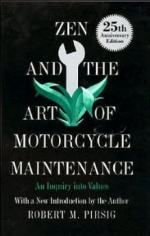
|
| Name: _________________________ | Period: ___________________ |
This test consists of 15 multiple choice questions and 5 short answer questions.
Multiple Choice Questions
1. The Narrator approaches maintaining his motorcycle like
(a) a person entering a bar for refreshment.
(b) a person entering a home for refuge from the world.
(c) a person entering a theater for entertainment.
(d) a person entering a church for a religious rite.
2. The professor meant that the bombing of the Japanese cities
(a) caused much destruction from fire.
(b) was a great idea that ended that part of the war.
(c) was not a part of reality.
(d) helped people have better understanding.
3. Sylvia says she thinks the Narrator looks like he saw a
(a) ghost.
(b) alien.
(c) wolf.
(d) cat.
4. John and Sylvia intensified their suffering by
(a) fighting with the Narrator.
(b) worrying about Chris.
(c) focusing on the heat.
(d) thinking about Phaedrus.
5. How does the Narrator know a storm is coming?
(a) He sees fast-moving thick, black clouds sweeping across the landscape.
(b) He feels the cool wind against his cheek.
(c) He sees lightening flashing on the horizon.
(d) He sees the edge of storm clouds on the horizon as they top a small hill.
6. Riding along the marshes reminds the Narrator of
(a) the loneliness of the two-lane road.
(b) the heat and humidity of the summer.
(c) the opening of duck season.
(d) how cold winters can be.
7. A supersaturated solution will only crystallize when certain conditions are met unless there is a
(a) sense of Quality.
(b) seed crystal.
(c) violent shaking.
(d) foreign object.
8. The theoretic component of man's existence corresponds to all EXCEPT
(a) esthetics.
(b) Western thought.
(c) classical thinking.
(d) the scientific process.
9. A priori knowledge is an idea that was proposed by
(a) Copernicus.
(b) Kant.
(c) Northrop.
(d) Hume.
10. Sylvia begins to ask questions about Chris'
(a) headaches.
(b) stomach pains.
(c) temper tantrums.
(d) depression.
11. John complains about how difficult it is to photograph the
(a) town of Ellendale.
(b) Narrator and Chris.
(c) prairie.
(d) motorcycles.
12. The woman who finds him in his classroom
(a) was a teacher of his.
(b) was a student of his.
(c) was married to him.
(d) was a colleague of his.
13. Why does the Narrator almost leave the building with Chris?
(a) He hears a car go by.
(b) He sees how frightened Chris is.
(c) He sees someone he doesn't want to talk with.
(d) He is afraid he will see Phaedrus.
14. The Narrator seems to think that technology is
(a) the incarnation of Buddha.
(b) a function of being human.
(c) a manifestation of Buddha.
(d) a necessary evil to be endured.
15. The kind of truth one seems to see out of the corner of one's eye or when the procedure goes haywire is called
(a) bilateral truth.
(b) frontal truth.
(c) lateral truth.
(d) literal truth.
Short Answer Questions
1. The building where Phaedrus taught was
2. Phaedrus called Montana State University
3. Phaedrus served in the
4. The Narrator ended the trip to Canada on the motorcycle because
5. A person consists of a personality,
|
This section contains 513 words (approx. 2 pages at 300 words per page) |

|




